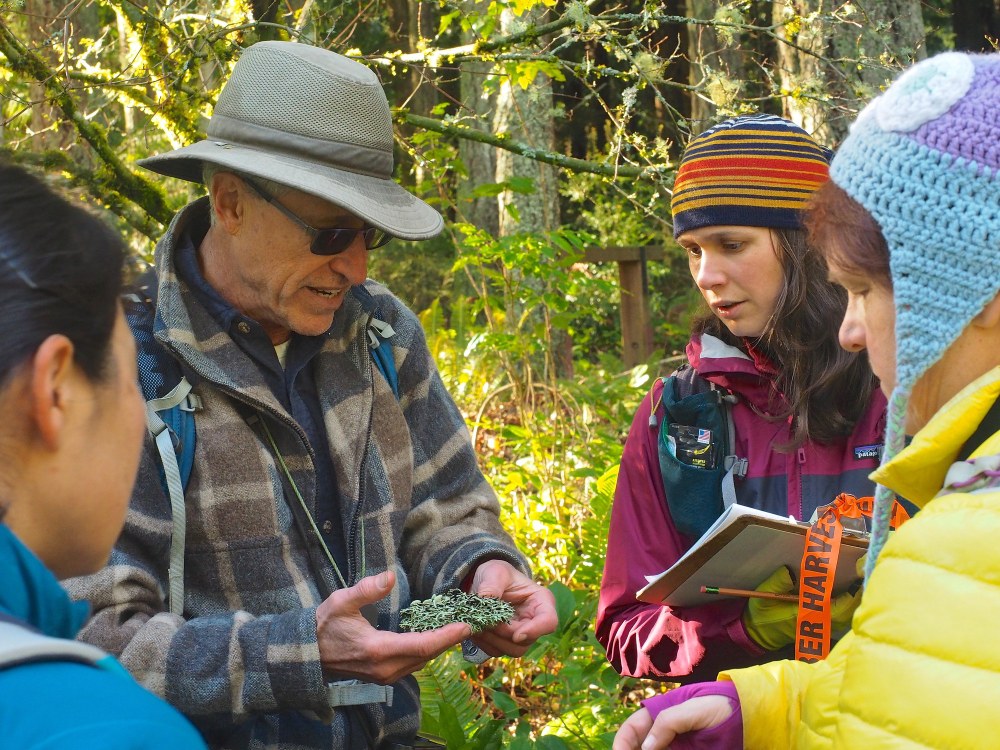
Mountain photography has been a passion of mine for over forty years, but I had little noticed (or perhaps intentionally ignored) mosses. After rejoining The Mountaineers in early 2015 to take the Introduction to the Natural World (INW) Course, I signed up for a few Naturalist activities that were oriented around mosses and lichens on wintertime hikes. I don’t recall wanting to learn about mosses and lichens - I barely knew what the latter were. I just wanted to expand my hiking repertoire. So I joined “moss hikes” on Cougar and Tiger Mountain.
By then I had been learning wildflowers for about ten years. I loved photographing wildflowers and would learn them by imaging what I saw and then returning home to compare my images to wildflower guides like Turner’s Wildflowers of the Pacific Northwest. I had several guides, and became familiar with the Burke Herbarium WTU Image Collection. Initially it was a somewhat slow but fun process.
Mosses, however, were very new to me. I tried the same photographic learning method I’d used for wildflowers. On those first Mountaineers moss hikes I shot a number of images. My ability to get good images was limited because mosses are all green and stick together when wet, have mostly unicellular leaves that show little contrast or differentiation to the camera, frequently have poor lighting, and require macro or near-macro images. Needless to say, my images were poor.
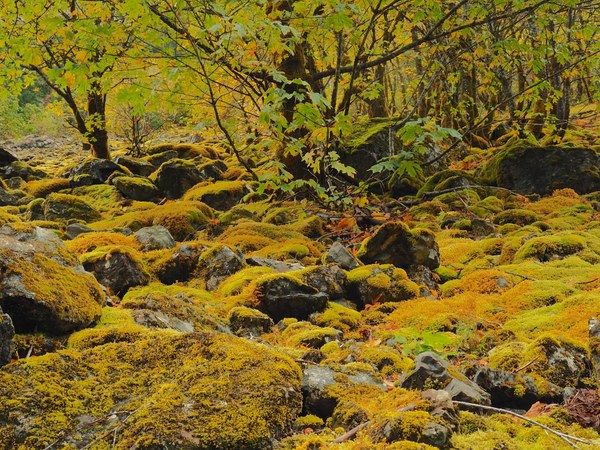 Rich assemblage of mosses in the North Cascades.
Rich assemblage of mosses in the North Cascades.
During the moss hikes, the leaders – Gordie Schwarzman and Bruce Barcklow – would point out various mosses. Frankly, few of them seemed distinctive to me. I struggled to learn and recall the names of more than four or five. My learning was slow and I was unhappy with most images. I thought I should have done better in both imaging and identification. Pojar’s Plants of the Pacific Northwest Coast was my initial guide, but it had just 65 mosses, and several were not of our region.
For the next couple years I gradually improved my moss, and then lichen, photography. I bought additional guides and obsessively threw myself at this project. But I made frustratingly slow progress in identification. It wasn’t until a three-day trip to the Olympic Rain Forest in 2016 that I began to progress. I visited the Hoh, Bogachiel, and Quinault areas, photographing mosses during the day and paging through my guides for several hours each evening, saying to myself, “Oh yeah, I saw this one, and this.” At home I reinforced my fledgling knowledge by reviewing my images.
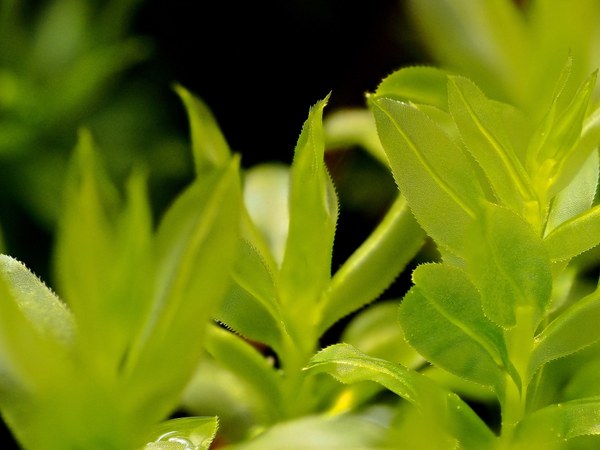 A macro image of mosses.
A macro image of mosses.
Still, when I encountered a new moss, especially one not evident in my guides, it could take me up to seven hours to identify just one. Other times I went back on some hikes because I needed more definitive images of a particular moss. I learned to focus stack these images.
My method of learning one moss randomly at a time is how most of us in the Naturalist group initially learned. When Bruce Barcklow, Stewart Hougen, and I took a two-day seminar at UW in 2016, that was the methodology used as well, in conjunction with microscopes. I wouldn’t recommend my method of learning mosses to anyone, unless you have an unlimited amount of time and patience.
The Origins of the Lichen and Moss Workshops
The modern history of Moss and Lichen Workshops at The Mountaineers goes back well beyond the current iteration. It began in 2008 when Don Schaectel was inspired to host his first Lichen Workshop after attending one led by Burke Herbarium Lichenologist Katherine Glew. In Don’s workshops, “participants were asked to arrange and label ….lichen specimens on a … posterboard” and then use hot glue guns to “glue them in place.” Their reference was Bruce McCune’s Macrolichens of the Pacific Northwest which Don says “is a great resource, though it may be a little technical for beginners.” Don was also instrumental in founding the first INW course in 2005. He remains active appreciating lichens, and continues to teach seminars to this day.
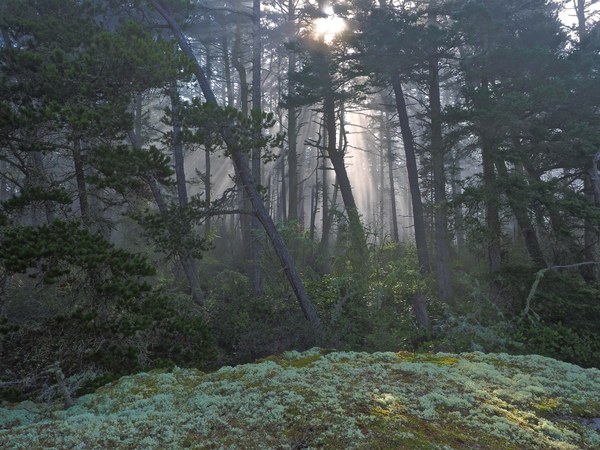 Fog creating microhabitat for mosses and lichens in the San Juans.
Fog creating microhabitat for mosses and lichens in the San Juans.
Cindy Luksus recalls that she and Don Schaectel hosted their first Lichen seminar together in 2011. “Don produced the first Mountaineers Lichen Key for common lichens in the PNW” (which Stewart modified in the course he first taught) and “students went home with a story board” that they were able to use during field trips to “identify the lichens themselves in nature.”
Cindy’s interest soon grew to mosses, and with the help of the Washington Native Plants Society and an Oregon seminar with eminent bryologist David Wagner, she began leading moss field trips for the Naturalists. In late 2012, she and current Naturalist Chair Lynn Graf, put on the first Mountaineer seminar on Bryophytes (mosses and liverworts) modeled after the Lichen seminar. “We had a grand time trying to collect all of the sample mosses and liverworts!” Cindy shares. “Because of the more fragile nature of these plants, we could not do a story board. We gave the students egg cartons and made them identify and label their samples.” Microscopes were used to better observe the mosses, and identification was determined using field guides and books available at the time.
Introducing ID Charts to Moss Workshops
Stewart Hougen taught a lichen identification course in 2016 which I attended. By then, Stewart was also teaching in the INW Course and had created a chart to give structure to students learning wildflowers. His initial reason for creating the chart was not for himself; “I was thinking of it as a teaching tool, rather than something I felt I needed.” In a stroke of teaching brilliance, he created a chart for the Naturalist Moss Class by categorizing mosses students might see into six distinctive visual categories. Traditional categorization was far simpler, categorized by Acrocarps (upright mosses) or as Pleurocarps (often well-branched and parallel to the substrate). Plant Families and Orders are also used in traditional categorization, but Stewart’s use of six visual categories was something new.
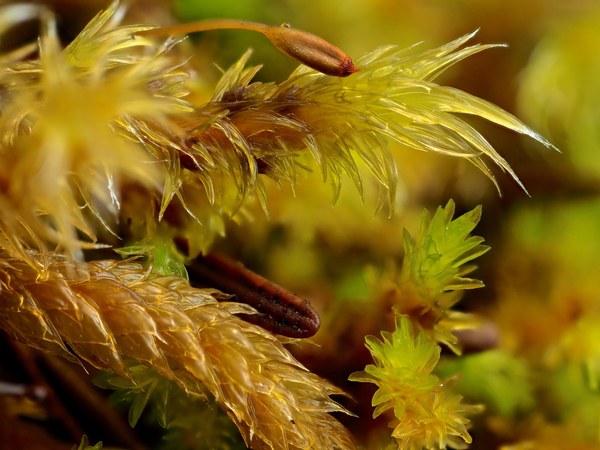 A macro assemblage of mosses.
A macro assemblage of mosses.
By 2017, I decided I could be useful in helping teach in the Moss and Lichen Workshop because my intense efforts had finally given me a fair base of knowledge. I was initially skeptical of the moss chart because one category – essentially a Pleurocarp – only worked as a catch-all for mosses that did not fit into any other categories. It worked in lowland forests of Western Washington because only a few mosses of that category are often seen there. We agreed that this chart was for “Lowland Pacific NW Forests” since it would not be as effective in a different habitat. But the chart at least gave students an effective window to begin learning mosses, and a far easier learning path than what I had used.
Without methodology, learning mosses is extremely difficult. Some 750 Washington mosses are very small, mostly green, and lack differentiation without close inspection. The initial challenge in this course and chart project was deciding which mosses should be included. Now with a broader base of personal knowledge, I pushed to include more mosses in the chart; Stewart, fewer.
Plant lists at the Washington Native Plant Society are not as readily available for mosses and lichens as they are for wildflowers. So, which mosses should be included? Here, I was able to help because my extensive photographic library had mosses by location or hike. It had become essentially a plant list.
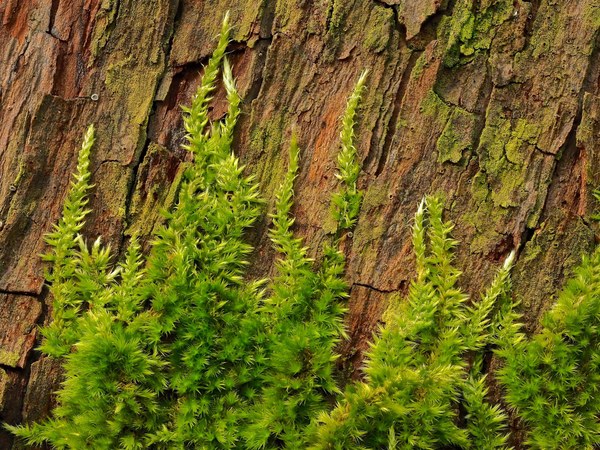 Beautiful moss in the San Juans.
Beautiful moss in the San Juans.
Stewart and I went back and forth on how to make the chart better. I strove to improve images of individual mosses, and we worked on more accurate and concise descriptions. I suggested that certain mosses would likely be found only in certain microhabitats, that some were particularly hydrophilic, while others were not. Some mosses were large, others tiny. But using too many words in the chart, just like including too many species, would make it overwhelming.
Stewart overcame this issue by utilizing various symbols to get these differentiations across while still keeping the moss chart verbiage as concise and simple as possible. Together, we developed a key for the Moss Workshop chart, and it continually improved. A very big component to learning mosses is recognizing the microhabitats in which certain mosses are found. A useful way of thinking about this is that each habitat represents a different subset of mosses. With respect to microhabitats, Stewart reminds us that this chart “puts mosses in their environment” through the various symbols used. Stewart says, “I still use the chart to solidify ideas in my head.”
Improving Course Materials and Inspiring Members to Explore the Natural World
Although the moss chart was a huge step in improving the learning process, I felt it still had serious geographic limitations. I wanted to give students a pathway to go beyond these “Lowland Forest Mosses” by providing a resource for them to identify mosses that they’d be likely to see in substantially different habitats. Not all 750 mosses, but at least some. Stewart’s excellent idea was to add an appendix to the course book so that students have a start to further moss identification on their own after the course. The original moss and lichen chart is now a 16 page book printed and bound on waterproof paper. We both feel it is a very good teaching tool for students. The course book also includes a few liverworts and a simpler chart of some twenty lichens.
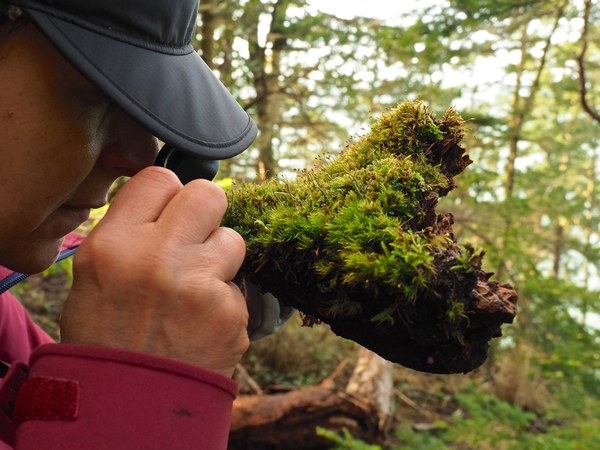 Renee Lenti using a loupe to study a moss.
Renee Lenti using a loupe to study a moss.
The initial feeling of being overwhelmed in the process of learning to identify mosses and lichens doesn’t have to be such an arduous process. This is also true in learning other aspects of the natural world with which we all want to feel connected. Structure can overcome what otherwise would feel like frustration for new learners in The Mountaineers. Our goal in The Mountaineers Naturalists is to both share experiences and to help others in the learning process of all natural elements. We are pleased that Moss and Lichen workshops are a valuable part of what the Naturalists group offers to others. Come see for yourself by attending one of our Naturalist courses or by attending one of our Naturalist activities. This year’s Moss and Lichen Workshop begins February 2 and includes small group field instruction at Redmond Watershed.
 Gary Brill
Gary Brill